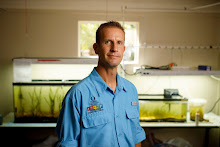The concrete igloo things are called reef balls. At this site they are used as breakwaters to protect the rock pile reefs behind them from being eroded by boat wakes, which is a big problem for natural reefs in Naples Bay.
A
bonus of the restoration is that the upper parts of many of the constructed
reefs have been colonized by mangroves. Mangroves are tropical trees that grow
in salt water and are helpful for protecting coastline from hurricanes,
providing fish and wildlife habitat, and performing various other "ecosystem
services" valuable to nature and humanity.
Today I kayaked to two of the reefs
with my undergraduate research students to count and measure the mangroves. Most
were red mangroves (Rhizophora mangle), but we also saw black mangroves
(Avicennia germinans), and white mangroves (Laguncularia racemosa). The site
constructed last year had just small mangroves, freshly sprouted from the
floating seedlings called propagules, while the site constructed seven years ago
had substantial saplings with some over a meter high.
Here my students are doing the official FGCU hand gesture, which is called "wings up" because our mascot is the bald eagle.
The students will analyze
their data in more detail to try to figure out the patterns, like why some areas
within the restoration site had tons of mangroves and others had relatively few. We
hope this work will inform and inspire other restoration practitioners.
PS- If
you have Florida waterfront, please let mangroves and other plants colonize and
grow along the shoreline. In addition to providing myriad benefits to nature
they will help protect your property from erosion.








No comments:
Post a Comment